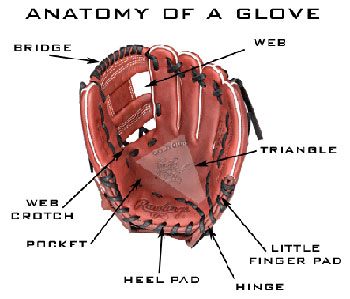
Did you know.............
The shape and size of a glove is described by its "pattern". Modern gloves have become quite specialized, with position-specific patterns:
- Catcher's mitts are called "mitts" because they lack individual fingers, like mittens. They have extra padding and a hinged, claw-like shape that helps them funnel 90+-mile-per-hour fastballs into the pocket, and provide a good target for pitchers. Some catchers use mitts with phosphorescent paint around the ridges to provide a clearer target for the pitcher. In addition, catcher's mitts come in single hinge and dual hinge varieties. If required to catch a knuckleball, a catcher will typically use an even larger mitt. Sizes of catcher's mitts, unlike those of other gloves, are measured around the circumference, and they typically have 32- to 34-inch patterns.
- First baseman's mitts also lack individual fingers. They are generally very long and wide to help them "pick or scoop" badly thrown balls from infielders. These mitts usually have 12.5- to 12.75-inch patterns, measured from wrist to the tip. Because first basemen are often left-handed, first basemen's mitts are readily available to fit on a right hand. Hank Greenberg is often credited as the first to wear this style of glove in the field.[4]Some catchers, such as Victor Martinez, use a first base mitt while catching knuckleballers.
- Infielders' gloves, unlike the first baseman's mitt, tend to be smaller. They have shallow pockets to allow fielders to remove the ball easily in order to make a quick throw to a base. Often the webbing will be open to allow dirt to move through the glove so that the infielder does not pull out a handful of dirt when trying to remove the ball from the glove. Infielder's gloves typically have 11- to 12-inch patterns, measured from the wrist to the tip.
- Pitchers' gloves usually have a closed, opaque webbing to allow pitchers to conceal their grip on the ball (which, in part, determines the behavior of the pitch in flight) from the batter.
- Outfielder's gloves are usually quite long with deep pockets, to help with catching fly balls on the run or in a dive, and to keep outfielders from having to bend down as far to field a ground ball. These gloves typically have 12- to 12.75-inch patterns, measured from wrist to the tip. They are frequently worn-in differently than those of infielders, with a flatter squeeze rather than the infielder's rounded style.
- Switch-thrower's gloves are gloves with a second thumb pocket on the opposite side of the glove to allow it to be worn on either side of the hand, as used by switch-pitcher Pat Venditte.
Slipping your hand into the perfect baseball or softball glove is like slipping into your favorite pair of shoes. It feels like it was made just for you, and allows for a comfortable and confident grip on the ball. But, getting to that point takes time and effort. That's where ProRollers comes in. Their professional baseball glove break in and softball glove conditioning services provide the best in technology and craftsmanship, ensuring that your glove feels like an extension of your hand from day one. Don't waste any more time breaking in your glove on your own - place your order today and experience the game-changing difference firsthand.
ReplyDelete